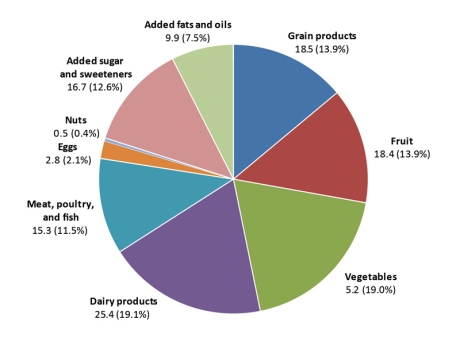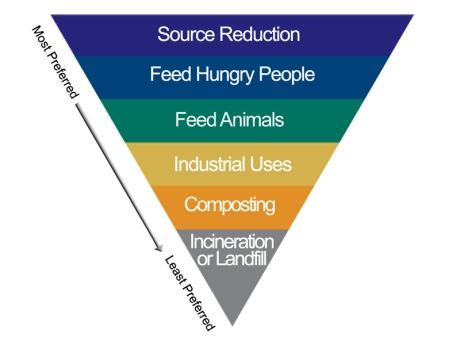Wasted Food
Background
With our abundant portions and food supply, every day is like Thanksgiving for many Americans. But far from celebrating food … many of us have adopted wasteful traditions that devalue food.4
– Jonathan Bloom, American Wasteland

U.S. waste by food group, in billions of pounds, 2010.
For all the investments of land, labor, and other resources that go into producing food for U.S. consumers, an estimated 31 to 40 percent of all food that is harvested is never eaten.1,2
For all the investments of land, labor, and other resources that go into producing food for U.S. consumers, an estimated 31 to 40 percent of all food that is harvested is never eaten.1,2 Each day, more than 1,250 calories per U.S. citizen are discarded from warehouses, stores, restaurants, refrigerators, and plates combined1,2—including irregularly shaped carrots discarded from packing plants because stores can’t sell them, remains of restaurant entrées that were too big to finish, and neglected bags of spinach that turned to mush in home refrigerators. Some food is never harvested from farms in the first place.
Why is so much food wasted, and why does it matter? There’s no single answer; waste occurs all across the food system, from farm to plate, for myriad reasons. Some of the causes, such as droughts and other natural disasters that destroy entire harvests, are beyond our control. Others, such as shoppers’ preferences for perfect produce, represent important opportunities for businesses and consumers to prevent food from going to waste. These efforts often involve finding ways to redirect food from the people who don’t want it to the people who do, putting the enormous human and environmental investments in food production to better use.
Why Wasted Food Matters

Bald eagle atop a Florida landfill.
Food represents the single largest component (21 percent) of solid waste in landfills and incinerators.6
Photo credit: Andrea Westmoreland. Creative Commons CC BY-SA 2.0.
Wasting food is a misuse of valuable human and natural resources. In the U.S., an estimated 25 percent of freshwater use is wasted producing food that is never eaten.2 When food is discarded, animals are unnecessarily raised and slaughtered, chemicals are sprayed for no benefit, and land and labor are spent nourishing crops that never nourish people.
Discarding food also means throwing away money. Farmers miss opportunities to profit when fields go unharvested. Grocery stores and restaurants lose money each time foods they stock go unsold. The estimated value of food discarded by U.S. consumers and food stores alone was over $160 billion in 2010.1
Less than 3 percent of U.S. wasted food is recovered (e.g., to feed people or animals) or composted, and the remainder is sent to landfills or incinerated.5 Food represents the single largest component (21 percent) of solid waste in landfills and incinerators.6 When wasted food decomposes in the absence of oxygen—as is the case when it is buried in landfills—the microorganisms that break it down release methane, a greenhouse gas with 21 times the global warming potential of carbon dioxide.
Why Food is Wasted
If you go back to Croatia, they load pears with a shovel. People have their paring knives and just carve out the bad spots. Here [in America] they gotta be perfect.
– Nick Ivicevich, pear grower7

Restaurants tend to serve large portions, which consumers may not be able to finish in one sitting. On average, diners leave an estimated 17 percent of their meals uneaten, and only 45 percent of these potential leftovers are taken home.8
Photo credit: Mia Cellucci, Johns Hopkins Center for a Livable Future.
Food is lost along all stages of the supply chain, from farm to plate. These are some of the reasons:
- Before food is harvested, crops may be lost to pests or bad weather, farmers might overestimate demand for a crop and plant more than they can sell, or there may be a shortage of farm workers to help with harvesting.8
- After harvest, a large portion of produce is discarded because it does not meet consumers’ expectations for size, shape, color, sweetness, or a flawless appearance.8 Not all is wasted, as some is composted or fed to animals.
- When food is processed and packaged for sale, edible parts such as skin, peels, and fat may be trimmed and discarded. Again, not all is wasted, as some is used for purposes such as animal feed or soup stock.8
- Grocery stores try to keep shelves bursting with food at all times to please their customers, even if it means stocking more food than they can sell before it spoils.8
- Restaurants tend to serve large portions, which consumers may not be able to finish in one sitting.
- Food stores and consumers regularly throw away food that has passed its “sell by,” “best by,” or “use by” date, including food that is perfectly edible. Contrary to what many consumers believe, expiration labels are manufacturers’ recommendations for peak quality and generally have nothing to do with food safety.9 Some of these problems stem from the attitude that it is cheaper and more convenient to dispose of unwanted food than to try to find ways to use it.3
Preventing Food From Going to Waste
Feed people, not landfills.
– U.S. Environmental Protection Agency6

The U.S. Environmental Protection Agency’s “Food Recovery Hierarchy” reminds us that the top priority for addressing wasted food is source reduction: businesses and individuals should avoid purchasing food that won’t be eaten (often easier said than done). Providing the food to those in need is a reasonable second choice. Composting wasted food can be beneficial for soils but still means a great deal of wasted resources.6
Image credit: U.S. Environmental Protection Agency.
Preventing food from going to waste starts with not buying more than is needed. Grocery store managers, for example, can examine their records to look for ways to avoid ordering more food than they can sell. Homes and restaurants can prepare smaller batches of food so leftovers don’t spoil before they can be eaten, reduce portion sizes to reduce plate waste, and find creative ways to use unwanted food (e.g., using vegetable trimmings in soup stock).6
When food waste can’t be prevented at the source, excess food—if it is safe to eat—can be donated or resold to people who want it. Gleaning, for example, is an ancient Hebrew tradition of allowing the poor to gather leftover food from farms and orchards. Today, gleaning groups help prevent food waste by working with farms, distribution warehouses, grocery stores, and other businesses to collect excess food and donate it to people in need. Small volunteer groups play an important role in these efforts, as do large anti-hunger organizations—some of which divert billions of pounds of unsold safe, healthy food from grocery stores to food insecure communities.
As a last resort to keep food out of landfills and incinerators, food that is unsuitable for eating can be used for animal feed or industrial uses, or composted. Composting is the process of decomposing food scraps, crop residues, animal manure, and other forms of organic matter. The finished product is a dark, spongy material that is added to soil to increase fertility, helping farmers grow more food. Homes, stores, and restaurants can compost their own organic matter, or they can send it to farms or specialized facilities for composting.
Resources
The following list of suggested resources is intended as a starting point for further exploration. Some materials may not reflect the views of the Johns Hopkins Center for a Livable Future.
For teachers
- Our Wasted Food (lesson plan). FoodSpan. Johns Hopkins Center for a Livable Future.
- Introduction to the US Food System: Public Health, Environment, and Equity (textbook). Neff RN (editor). Johns Hopkins Center for a Livable Future. 2014.
Reports and websites
- A Road Map to Reduce U.S. Food Waste by 20 Percent. ReFED. 2016
- The Importance of Reducing Animal Product Consumption and Wasted Food in Mitigating Catastrophic Climate Change. Kim B, Neff R, et al. Johns Hopkins Center for a Livable Future. 2015.
- The Dating Game: How Confusing Food Date Labels Lead to Food Waste in America. NRDC and Harvard Food Law and Policy Clinic. 2013.
- Wasted: How America Is Losing Up to 40 Percent of Its Food from Farm to Fork to Landfill. Gunders D. NRDC. 2012.
- Global Food Losses and Food Waste. Gustavsson J, Cederberg C, et al. UN FAO. 2011.
Websites
- EndFoodWaste.org. U.S. Environmental Protection Agency.
- Food Waste Reduction Alliance.
- Wasted Food. Jonathan Bloom.
Academic journal articles
- Wasted Food: U.S. Consumers' Reported Awareness, Attitudes, and Behaviors (open access). Neff RA, Spiker ML, Truant PL. PLOS One. 2015.
- Wasted Seafood in the United States: Quantifying Loss from Production to Consumption and Moving Toward Solutions (open access). Love DC, Fry JP, et al. Global Environmental Change. 2015.
- Reducing Food Loss and Waste While Improving the Public’s Health. Neff RA, Kanter R, Vandevijvere S. HealthAffairs. 2015.
- Spaghetti soup: The complex world of food waste behaviours. Quested TE, Marsh E, et al. 2013.
- The Progressive Increase of Food Waste in America and Its Environmental Impact (open access). Hall KD, Guo J, et al. PLOS One. 2009.
Films
- Just Eat It: A Food Waste Story. 2014.
- Taste the Waste. 2011.
- Dive! Living Off America's Waste. 2010.
References
1. Buzby JC, Wells HF, Hyman J. The Estimated Amount, Value, and Calories of Postharvest Food Losses at the Retail and Consumer Levels in the United States. USDA ERS; 2014.
2. Hall KD, Guo J, Dore M, Chow CC. The progressive increase of food waste in America and its environmental impact. PLoS One. 2009;4(11).
3. Gustavsson J, Cederberg C, Sonesson U, Otterdijk R van, Meybeck A. Global Food Losses and Food Waste. Food and Agriculture Organization of the United Nations; 2011.
4. Bloom J. An Abundance of Food, Wasted. The New York Times. November 27, 2008.
5. U.S. Environmental Protection Agency. Basic Information about Food Waste. 2012.
6. U.S. Environmental Protection Agency. Reducing Food Waste for Business. 2014.
7. Bloom J. American Wasteland. Da Capo Press; 2010.
8. Gunders D. Wasted: How America Is Losing Up to 40 Percent of Its Food from Farm to Fork to Landfill. NRDC; 2012.
9. Leib EB, Gunders D, Ferro J, Nielsen A, Nosek G, Qu J. The Dating Game: How Confusing Food Date Labels Lead to Food Waste in America. Harvard Food Law and Policy Clinic and the Natural Resources Defense Council; 2013.
